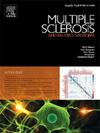多发性硬化症患者顺磁边缘病变与髋部铁缺乏之间的关系。
IF 2.9
3区 医学
Q2 CLINICAL NEUROLOGY
引用次数: 0
摘要
背景:慢性活动性病变周围的深部灰质(DGM),特别是枕后脑,和白质已经显示出铁水平的减少,表明可能的机制联系。然而,没有研究调查这些现象之间的潜在关系。目的:本研究旨在确定prl是否与颅底铁缺失有关,如果是,这种关系是否具有空间介导性。方法:回顾性分析139例多发性硬化患者(pwMS)和43例健康对照(hc),分别在基线和5.4±0.6年后进行3T MRI扫描。从定量敏感性图中估计了Pulvinar铁浓度(cFe)和铁质量(mFe),并检测了与prl的关系。纳入96例prl和倾向匹配hc的pwMS单独队列,以评估斑块周围正常白质(NAWM)异常。结果:PRL数与肺动脉cFe (β = -0.265, p = 0.005)和mFe (β = -0.256, p = 0.006)下降相关。prl周围斑块周围NAWM敏感性增加11mm, prl到pulvinar的距离越短,pulvinar cFe (β = 0.380, p = 0.005)和mFe (β = 0.348, p = 0.022)的下降幅度越大。结论:我们的研究结果支持prl与慢性脉铁缺乏之间的空间介导关系。本文章由计算机程序翻译,如有差异,请以英文原文为准。
Association between paramagnetic rim lesions and pulvinar iron depletion in persons with multiple sclerosis
Background
The deep gray matter (DGM), especially the pulvinar, and the white matter surrounding chronic active lesions have demonstrated depleted iron levels, indicating a possible mechanistic link. However, no studies have investigated the potential relationship between these phenomena.
Objectives
The study aimed to determine whether PRLs were associated with pulvinar iron depletion and, if so, whether this relationship was spatially mediated.
Methods
This retrospective analysis included 139 people with MS (pwMS) and 43 healthy controls (HCs) scanned at 3T MRI at baseline and after 5.4 ± 0.6 years. Pulvinar iron concentrations (cFe) and iron masses (mFe) were estimated from quantitative susceptibility maps and tested for associations with PRLs. A separate cohort of 96 pwMS with PRLs and propensity-matched HCs was included to evaluate peri‑plaque normal-appearing white matter (NAWM) abnormalities.
Results
PRL number was associated with greater decline in pulvinar cFe (β = -0.265, p = 0.005) and mFe (β = -0.256, p = 0.006). Peri-plaque NAWM susceptibility was increased 11 mm surrounding PRLs, outside which shorter PRL-to-pulvinar distance was associated with greater decline in pulvinar cFe (β = 0.380, p = 0.005) and mFe (β = 0.348, p = 0.022).
Conclusions
Our findings support a spatially-mediated relationship between PRLs and chronic pulvinar iron depletion.
求助全文
通过发布文献求助,成功后即可免费获取论文全文。
去求助
来源期刊

Multiple sclerosis and related disorders
CLINICAL NEUROLOGY-
CiteScore
5.80
自引率
20.00%
发文量
814
审稿时长
66 days
期刊介绍:
Multiple Sclerosis is an area of ever expanding research and escalating publications. Multiple Sclerosis and Related Disorders is a wide ranging international journal supported by key researchers from all neuroscience domains that focus on MS and associated disease of the central nervous system. The primary aim of this new journal is the rapid publication of high quality original research in the field. Important secondary aims will be timely updates and editorials on important scientific and clinical care advances, controversies in the field, and invited opinion articles from current thought leaders on topical issues. One section of the journal will focus on teaching, written to enhance the practice of community and academic neurologists involved in the care of MS patients. Summaries of key articles written for a lay audience will be provided as an on-line resource.
A team of four chief editors is supported by leading section editors who will commission and appraise original and review articles concerning: clinical neurology, neuroimaging, neuropathology, neuroepidemiology, therapeutics, genetics / transcriptomics, experimental models, neuroimmunology, biomarkers, neuropsychology, neurorehabilitation, measurement scales, teaching, neuroethics and lay communication.
 求助内容:
求助内容: 应助结果提醒方式:
应助结果提醒方式:


